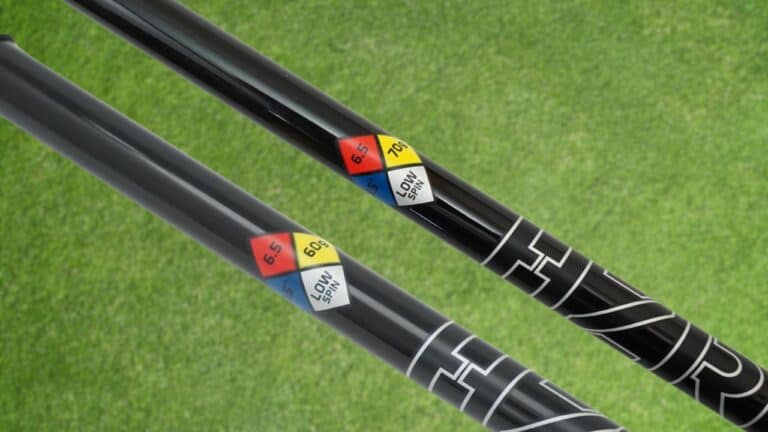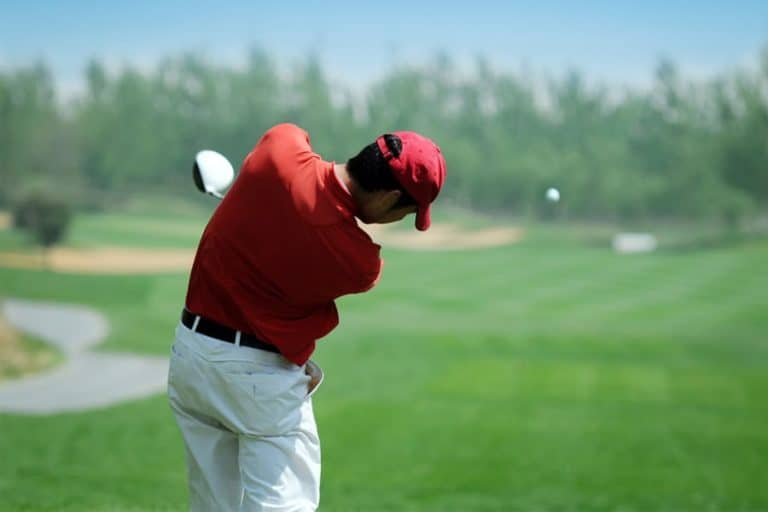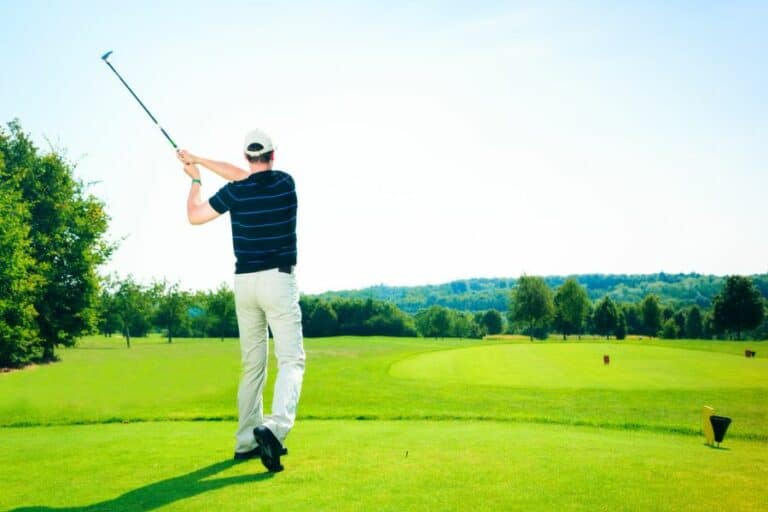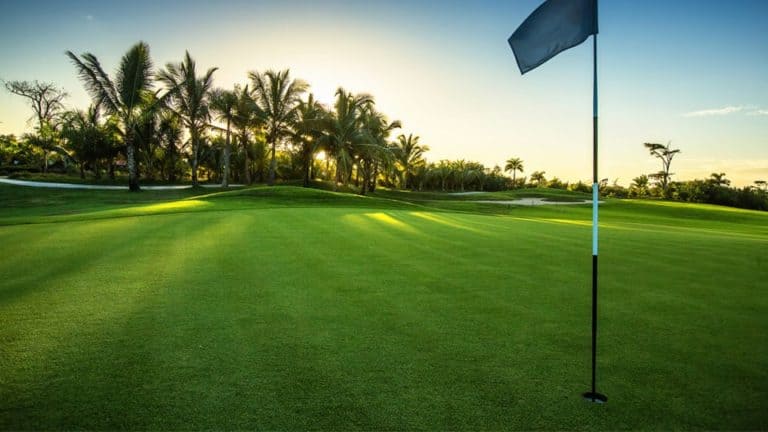Wrist Hinge Golf – What Is It And How To Do It Correctly

Master the proper wrist hinge in golf for greater power and accuracy. Learn how to achieve the perfect angle and improve your swing today.
Wrist hinge is a crucial aspect of a golfer’s swing that can greatly impact their shot accuracy and distance. Understanding the proper technique for wrist hinge can improve a golfer’s game.
Let’s explore the importance of wrist hinge golf and discover tips for mastering this technique.
I. What is the (proper) wrist hinge in golf?
The wrist hinge in golf refers to the angle formed between the club shaft and the lead wrist during the backswing. It is a key element in generating power and accuracy in the golf swing.
In golf, there is no particular term as Proper Wrist Hinge. However, the proper wrist hinge in golf is a technique that can vary depending on the player and their swing. However, there are certain wrist angles during the impact that are considered ideal and have been studied by professional golfers. The goal is to get your club into the right position at impact, regardless of how you take the club back.
The timing of your wrist hinge can affect the sequence of events needed to square the clubface, which greatly impacts the clubface’s angle. So, finding the right amount of wrist hinge is essential for a successful golf swing.
1. The Front Wrist
In wrist hinge golf, the front wrist refers to the wrist that is closest to the target. For right-handed golfers, this would be the left wrist, and for left-handed golfers, it would be the right wrist. The front wrist plays a crucial role in creating the proper wrist hinge during the backswing.
By maintaining a relaxed grip and allowing the front wrist to hinge naturally, golfers can generate power and accuracy in their swing. It’s important to find the right balance between wrist hinge and control, to achieve consistent shots and better results on the course.
2. The Back Wrist
In wrist hinge golf, the back wrist refers to the wrist farthest away from the target. For right-handed golfers, this would be the right wrist, and for left-handed golfers, it would be the left wrist. The back wrist also plays a critical role in creating the proper wrist hinge during the backswing.
By maintaining a relaxed grip and allowing the back wrist to hinge naturally, golfers can generate more power and distance in their swing. However, excessive hinge or manipulation can lead to inconsistency and a lack of control. Finding the right balance between wrist hinge and control is key to a successful golf swing.
II. How to achieve right wrist movement?
To make sure you’re using the right wrist movement in your golf swing, pay attention to how you hinge your wrists. Imagine your swing is divided into percentages. When you’re 25% into your backswing, your wrists should be 25% hinged, and so on throughout the entire swing. This means that when your swing is complete, your wrists should be fully hinged.
Now, the key is to hinge your wrists in the correct direction. During your practice swing, observe how your wrists move. If you notice them hinging sideways, that’s not the right way. Instead, focus on hinging them upwards during the takeaway and downwards during the follow-through. This proper wrist movement will help your golf swing work better and avoid unnecessary issues.
III. The Importance of wrist hinge golf swing
In golf, the wrists play a vital role in controlling the clubface. Your ability to manage the wrist hinge can determine whether you achieve a square clubface at impact. This hinge affects your club’s positioning at the top of the swing, which then impacts your transition to the downswing and your clubface at impact.
To improve your awareness of the wrist hinge, try the following drill.
Take one swing without hinging your wrists until the top of the swing, and then take another swing where you set your wrists almost immediately after taking the clubface away from the ball. The difference between these two swings can have a significant impact on your game.
Moments of setting your wrists in the golf swing
The wrist hinge in golf can happen at two points during your takeaway, either when your lead arm is parallel to the ground or near the top of your backswing. Golf instructors agree that the wrists must hinge at some point for an effective swing.
If you don’t hinge your wrists and limit your shoulder and hip turn, you may dip into your left side, leading to poor rotation in the downswing and inconsistent ball contact.
Allowing your wrists to break at the top of your backswing promotes a centered stance, bigger turn, and hip rotation through impact for solid ball striking.
IV. Three wrist hinge positions
Three wrist hinge positions refer to the different angles at which the wrist can be flexed or extended during a golf swing. These positions can have a significant impact on the direction and distance of the shot.
1. Flat Left Wrist
In golf, the position of your left wrist at the top of your swing can greatly impact your shot. The most widely accepted position is the flat wrist, where the back of your front wrist stays flat at the top of your swing. This allows for a sideways movement toward the target while maintaining a flat wrist.
2. Bowed Left Wrist
Another position is the bowed wrist, where the front wrist is bowed at the top of the backswing. This can be difficult to achieve but can add some distance to your shots, and some PGA tour pros like Dustin Johnson use it.
3. Cupped Wrist Position
However, the cupped wrist position, where the front wrist is bent backward at the top of the backswing, is less than ideal unless you have excellent hand-eye coordination. This position adds another significant moving part to your swing and can be challenging to execute properly. If done correctly, it can also add some distance to your shots.
V. The effect of wrist hinge on backswing
Wrist hinge is a crucial factor that affects the backswing in a golf swing. It helps to generate more clubhead speed, power, and control, but excessive wrist hinge can lead to poor ball striking by moving the club off the plane. Conversely, insufficient wrist hinge can result in a lack of distance and power. To achieve a consistent and effective backswing, it is vital to find the right balance of the wrist hinge.
VI. Techniques to master wrist hinge
If you want to improve your golf game, mastering the wrist hinge is a must. Here are 7 techniques that can help you achieve the perfect wrist hinge and hit those shots with more accuracy and power.
- Start with a relaxed posture of your arms, hands, and wrists at setup.
- Practice shifting your weight to your rear leg to prepare for the swing.
- As you reach a shoulder turn of 45 degrees, start turning your body.
- Keep your wrists relaxed and allow them to hinge upwards naturally to support the weight of the club.
- At the end of the takeaway, make sure the club is parallel to the ground.
- When your lead arm (left for right-handers) is parallel to the ground, form the letter ‘L’ with the club pointing upwards.
- Maintain light tension in your wrists and let them fully hinge as you start your downswing, creating more lag and increasing your distance.
VII. The full wrist hinge at the top
The full wrist hinge at the top technique is advantageous for golfers who want to improve their lower-than-normal ball flight. This will help them ensure that their wrists are appropriately positioned at the top at the time of taking the shot.
By starting your downswing with fully hinged wrists, you will create what is known as “lag,” which is when your hands move past the ball before the clubhead, leading to a more solid impact. However, it’s important not to release the hinge too soon, as this can negatively affect your shot.
In addition, fully hinged wrists promote a whipping motion as the clubhead moves towards the ball, which can increase distance and promote the ideal ball flight height.
VIII. Why is too much wrist hinge bad?
Many golfers often hinge their wrists too quickly in the swing. A few years ago, some professionals popularized early wrist setting which caused confusion for the beginners.
Unfortunately, this led to golfers usually pulling the club too fast behind their body and disrupting the proper swing plane. As a result, golfers had to make changes in their swings during the downswing to recover their game.
Conclusion
In conclusion, mastering the wrist hinge in golf can have a significant impact on your game. It allows you to create more power and distance while also promoting solid contact with the ball. However, it’s important to find the right balance and avoid excessive tension in your wrists. With practice and proper technique, incorporating the wrist hinge into your swing can lead to better results on the course.
FAQs
1. Which Is Better – Cupped, Bowed, Or Neutral Wrist Position?
It is generally preferred to maintain a neutral wrist position at the top of the backswing in golf. However, it is also possible for golfers to hit high-quality shots even with a cupped or bowed wrist position. The key to achieving this is to coordinate the movements of the hips, chest, and arms during the impact. This synchronization can help golfers achieve a consistent and accurate swing, regardless of their wrist position at the top of the backswing.
2. Do Wrists Hinge Naturally In The Backswing?
As you swing back, your wrists will naturally hinge, and you should allow this to happen without any forced movement. Once you reach the top of your backswing, you can then start to unwind your arms, wrists, and body in a wider arc to create more power and hit longer, straighter drives down the fairway.
3. What happens if my wrists hinge too much?
Excessive wrist hinge in golf swing can lead to a challenging or hard position which often puts you on a too-upright plane. This may require slowing down or flipping the club at impact to square the clubface.
4. What happens if you don’t hinge your wrists in a golf swing?
Failing to hinge your wrists during your golf swing can result in a considerable loss of power. It can also lead to inaccuracies in the angle of descent towards the golf ball, potentially affecting its flight path.
5. Can you hinge wrists with the driver?
Yes, golfers can hinge their wrists while using a driver. However, it is suggested that you wait until your golf club is fully extended and your backswing brings it close to the top for the best performance.








